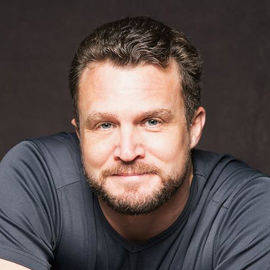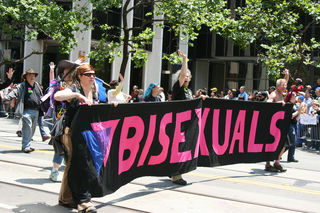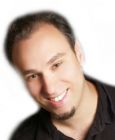Sex
Beyond Binary: How Bisexuality Shifts Orientation Science
Current research on bisexuality challenges our understandings of orientation.
Posted May 8, 2017
This is the second installment of interviews with speakers from the 2nd Annual AltSex NYC Conference, which was held on April 28 in New York City. Dr. David Ley is a sexuality expert, best known for his books including Ethical Porn for Dicks and The Myth of Sex Addiction. His presentation on the burgeoning research on bisexuality provided insights into our rapidly developing and changing understanding of sexual orientation.

Q: Seventeen percent of women have had same-sex experiences, but only 6 percent of men. Likewise, 6 percent of women but only 2 percent of men identify as bisexual. However, a recent study of British millennials found that 49 percent don't identify as entirely heterosexual. How do you make sense of all of this?
A: We used to treat sexuality, and orientation, as though these were simple, homogeneous concepts. But increasingly, we are finding that sexual behavior, arousal, and orientation/identity are distinct, overlapping, and related concepts. Further, they are differently affected by social expectations, development, and biology. Finally, there appear to be huge generational shifts in the works about sexuality, identity, and behavior. This leaves us in the midst of a "sea change" environment, and we can only really wait and see to find out what sexuality, orientation, and identity will look like in the future. The broadening realm of bisexuality and the many different nuances between "straight" and "gay" are where most of these developments are happening.
Q: Other research you've cited showed that bi women have a higher libido, but bi men have less; high-libido men are either "very" gay or straight. Why these gender differences, and what are the possible implications?
A: Bisexuality appears to express differently in males and females. This appears to be a complex interaction of factors such as: the social suppression of female sexuality; the shunning of male same-sex behaviors; the encouragement of women to be sexual with other women, such as in the bar scene or swinging; and the research showing that women respond physiologically to a diversity of stimuli, including same-sex images, whereas men do not, or at least not as often
My developing theory is that males and females have different "windows" of influence on sexual fluidity. Male sexual or erotic templates are a bit more, well, "rigid," whereas female erotic templates can be more fluid across the lifespan. It's one reason why we see greater rates of fetishes and sexual disorders in males. It's also why male bisexuality may look a bit different than female bisexuality.
Of course, all these terms imply a gender binary, but we have to accept that there are many people who don't fit, or match, a binary model. So these theories and findings may not be — and probably are not — universal. We are learning, from bisexuality and other aspects of sexual research, that human sexuality is intensely nuanced and context-dependent. We must stop trying to make it simple.
Q: Personality-wise, bisexuals score lower on Conscientiousness, but higher on both Openness to New Experiences and Neuroticism. How do you think these personality traits relate to sexuality, particularly bisexuality?
A: The real question is "chicken or egg?" Do these personality traits, which are highly biologically influenced, come first and drive the development of bisexual identity or behavior pattern? Or do these patterns reflect an interaction between a person's sexuality with their biology and the environment? It's a fascinating and complex question.
Neuroticism is commonly interpreted as an anxiety symptom, consistent with the high levels of depression and anxiety reported in bisexuals, who experience high levels of stigma and rejection from both heterosexuals and homosexuals. But some researchers suggest that this, paired with low Conscientiousness, may also be a reflection of some potential that bisexuality is a form of individual rejection of social norms. Essentially, bisexual behavior may sometimes be a "screw you" to sociosexual rules and norms.
Q: What does the research have to say on the role of biology and hormones on bisexuality?
A: We are still learning. There are hints that hormonal development may influence the degree to which females and males are open to same-sex attractions. They might perhaps influence the development of sexual fluidity. There have been a few studies which found that fetal exposure to certain hormone-affecting medications influenced later sexual behaviors as an adult. But this is intensely complex and context-dependent, and cannot be reduced to simple specific factors.

Q: You've mentioned a number of orientation identities, including pansexual, omnisexual, heteroflexible, and "mostly straight." What do all of these terms mean, and how are they different from bisexuality?
A: I treated a man once who was bisexual, and very interested in sex with men, but not at all interested in falling in love with a man. He would be what some folks today call "heteroromantic bisexual." There are a growing number of different identity terms to describe the millions of nuances between gay and straight. I call this "colonizing the middle." All of these terms, concepts, and identities represent the degree to which people are now embracing and accepting their bisexual identity, arousal, and behavior, and are expressing the things that make it unique for them. As this happens, we learn more and more about all the different nuances and contextual factors that define the incredible richness present in these varying flavors of sexual identity, arousal, and behavior.
Researchers Ritch Savins-Williams and Zhana Vrangalova find that "mostly straight" may be the largest group of sexual minority, representing people who identify as straight but have occasional same-sex arousal or behaviors. This is a flavor of bisexuality in people who express bisexual behavior but choose not to embrace the identity. Much of that is about the stigma associated with these identities. But this is one of the places where we make it very difficult for people, often telling them that they aren't "really" bisexual, or that they must identify as bisexual to avoid bi erasure. Unfortunately, that pressure leads to people rejecting it all and keeping their bisexuality private. It's one of the places where liberals and sexually diverse people use the same shaming and social conformity pressures common in conservatives. Bisexuals, in all their many stripes, are, I think, the new frontier of growth, development, and understanding for sexuality.

Q: You've cited a researcher who suggested 34 bisexuality subtypes, including ritual, performative, and situational bisexuality. How are they all different?
A: That's Eric Anderson, a sexual researcher currently living in the UK. In his new book about bisexuality, he and his co-author suggest there are many different kinds of bisexuality, ranging from men who do "gay for pay" sex in porn films but identify as straight, to men who engage in homosexual behavior while in prison, but are straight in the rest of their life. Women in female-only schools show similar patterns. Anderson and McCormack also suggest the use of sexual "thermometers" to measure the degree and intensity of people's interest in men and women as one way to move away from our view of sexuality as a one-dimensional spectrum.
Q: You've cited some interesting quotes highlighting the tension between a bisexual identity and other identities that seem to distance themselves from or "erase" bisexuality. For example, "I'm straight, but a pervert. A bi guy is just attracted to either." Can you offer a little more insight into some of the dynamics going, on in terms of why someone would choose one identity and distance from another?
A: It is the tension in bisexuality, and our view of it, that I find particularly compelling and interesting. Increasingly, there are men who engage in group sex, sharing a woman with another man and not freaking out at same-sex contact. Some men refer to sex with other men as just "helping a bro out." All this tension is truly fascinating and reflects the growth, development, and sea change that is happening right now.
Bisexuality is not simple. It's complex, contradictory, nuanced, and context-dependent. I kept wanting it to be simple, definable, and concrete, so I could break it down more easily. But ultimately I realized that in this complexity, in this highly nuanced area, we must instead turn toward developing healthy, positive sexual values. Rather than trying to define, concretize, and nail down what bisexuality is, we should be more focused on helping people to do it well. The message of bisexuality is that it really doesn't matter who you fantasize about, who you love, or who you have sex with. What matters is how you do it, who you are, and who you choose to be. This is the lesson that I hope bisexuality can teach us all.
Facebook image: Air Images/Shutterstock




